Can Forceps Leave Dents in the Baby's Skull
| Forceps in childbirth | |
|---|---|
 Drawing of childbirth with use of forceps past Smellie | |
| ICD-9-CM | 72.0-72.iv |
Obstetrical forceps are a medical instrument used in childbirth. Their use can serve as an alternative to the ventouse (vacuum extraction) method.
Medical uses [edit]
Forceps births, like all assisted births, should only be undertaken to aid promote the health of the mother or baby. In general, a forceps birth is likely to be safer for both the female parent and infant than the alternatives – either a ventouse nascence or a caesarean section – although caveats such as operator skill apply.[ane]
Advantages of forceps employ include avoidance of caesarean section (and the short and long-term complications that accompany this), reduction of delivery fourth dimension, and general applicability with cephalic presentation (head presentation). Common complications include the possibility of bruising the infant and causing more than severe vaginal tears (perineal laceration) than would otherwise be the case (although information technology is important to recognise that almost all women volition sustain some form of tear when delivering their first baby). Severe and rare complications (occurring less ofttimes than 1 in 200) include nerve damage, Descemet's membrane rupture,[2] skull fractures, and cervical cord injury.
- Maternal factors for apply of forceps:
- Maternal exhaustion.
- Prolonged 2nd phase of labour.
- Maternal disease such every bit eye illness, hypertension, glaucoma, aneurysm, or other conditions that make pushing difficult or dangerous.
- Hemorrhaging.
- Analgesic drug-related inhibition of maternal effort (especially with epidural/spinal anaesthesia).
- Fetal factors for use of forceps:
- Not-reassuring fetal heart tracing.
- Fetal distress.
- After-coming head in breech delivery.
Complications [edit]
Babe [edit]
- Cuts and bruises.
- Increased risk of facial nervus injury (usually temporary).
- Increased risk of clavicle fracture (rare).
- Increased risk of intracranial hemorrhage - sometimes leading to expiry: four/ten,000.[3]
- Increased risk of damage to cranial nerve Six, resulting in strabismus.
Mother [edit]
- Increased take chances of perineal lacerations, pelvic organ prolapse, and incontinence.
- Increased gamble of injury to vagina and cervix.
- Increased postnatal recovery fourth dimension and pain.
- Increased difficulty evacuating during recovery time.
Construction [edit]

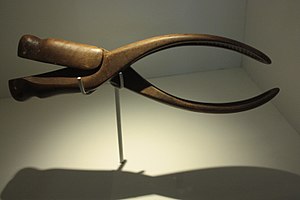
Wooden forceps c.1800, Hunterian Museum, Glasgow
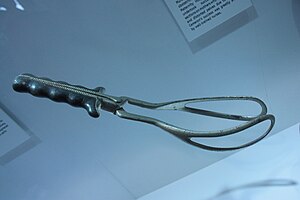
James Young Simpson's Caesarian forceps, Hunterian Museum, Glasgow
Obstetric forceps consist of ii branches (blades) that are positioned around the caput of the fetus. These branches are defined every bit left and right depending on which side of the mother'southward pelvis they volition be applied. The branches ordinarily, but not always, cantankerous at a midpoint, which is called the articulation. Almost forceps take a locking mechanism at the joint, but a few accept a sliding machinery instead that allows the ii branches to slide along each other. Forceps with a fixed lock mechanism are used for deliveries where piffling or no rotation is required, every bit when the fetal caput is in line with the female parent's pelvis. Forceps with a sliding lock mechanism are used for deliveries requiring more rotation.[iv]
The blade of each forceps branch is the curved portion that is used to grasp the fetal head. The forceps should surround the fetal caput firmly, merely not tightly. The blade characteristically has two curves, the cephalic and the pelvic curves. The cephalic curve is shaped to adjust to the fetal head. The cephalic curve tin be rounded or rather elongated depending on the shape of the fetal head. The pelvic curve is shaped to accommodate to the birth canal and helps direct the force of the traction under the pubic os. Forceps used for rotation of the fetal head should have most no pelvic bend.[4]
The handles are connected to the blades by shanks of variable lengths. Forceps with longer shanks are used if rotation is being considered.[4]
Anglo-American types [edit]
All American forceps are derived from French forceps (long forceps) or English language forceps (short forceps). Short forceps are practical on the fetal head already descended significantly in the maternal pelvis (i.e., proximal to the vagina). Long forceps are able to reach a fetal head yet in the middle or fifty-fifty in the upper part of the maternal pelvis. At present do, it is uncommon to use forceps to access a fetal caput in the upper pelvis. And then, short forceps are preferred in the UK and USA. Long forceps are still in utilize elsewhere.
Simpson forceps (1848) are the most commonly used among the types of forceps and has an elongated cephalic bend. These are used when at that place is substantial molding, that is, temporary elongation of the fetal caput as it moves through the nascence canal.[4]
Elliot forceps (1860) are similar to Simpson forceps only with an adjustable pin in the stop of the handles which tin can be drawn out as a means of regulating the lateral pressure on the handles when the instrument is positioned for use. They are used near often with women who have had at to the lowest degree one previous vaginal delivery considering the muscles and ligaments of the nativity canal provide less resistance during 2nd and subsequent deliveries. In these cases the fetal head may thus remain rounder.[four]
Kielland forceps (1915, Norwegian) are distinguished by having no angle between the shanks and the blades and a sliding lock. The pelvic curve of the blades is identical to all other forceps. The mutual misperception that there is no pelvic curve has become then entrenched in the obstetric literature that it may never be able to be overcome, only information technology can be proved by holding a blade of Kielland's against any other forceps of one's choice. Kielland forceps are probably the most common forceps used for rotation. The sliding mechanism at the joint tin can be helpful in asynclitic births[4] (when the fetal head is tilted to the side)[5] since it is no longer in line with the birth canal.[4] Because the handles, shanks, and blades are all in the same airplane the forceps can be applied in any position to impact rotation. Considering the shanks and handles are not angled, the forceps cannot be applied to a high station every bit readily as those with the angle since the shanks impinge on the perineum.
Wrigley'southward forceps, named after Arthur Joseph Wrigley, are used in depression or outlet deliveries (see explanations below),[vi] when the maximum bore is nearly 2.5 cm (0.98 in) above the vulva.[vii] Wrigley's forceps were designed for employ by full general practitioner obstetricians, having the safety characteristic of an inability to reach loftier into the pelvis.[7] Obstetricians now use these forceps nigh commonly in cesarean section delivery where manual traction is proving difficult. The short length results in a lower run a risk of uterine rupture.
Piper's forceps has a perineal bend to allow awarding to the after-coming caput in breech delivery.
Technique [edit]
The cervix must be fully dilated and retracted and the membranes ruptured. The urinary bladder should be empty, maybe with the use of a catheter. Loftier forceps are never indicated in the mod era. Mid forceps can occasionally be indicated just crave operator skill and caution. The station of the head must be at the level of the ischial spines. The adult female is placed on her back, unremarkably with the aid of stirrups or assistants to support her legs. A regional anaesthetic (usually either a spinal, epidural or pudendal block) is used to help the female parent remain comfortable during the birth. Ascertaining the precise position of the fetal head is paramount, and though historically was accomplished by feeling the fetal skull suture lines and fontanelles, in the modern era, confirmation with ultrasound is substantially mandatory. At this point, the two blades of the forceps are individually inserted, the left blade first for the commonest occipito-inductive position; posterior bract first if a transverse position, and so locked. The position on the babe's head is checked. The fetal head is then rotated to the occiput inductive position if it is not already in that position. An episiotomy may be performed if necessary. The baby is then delivered with gentle (maximum 30 lbf or 130 Newton[8]) traction in the centrality of the pelvis.[nine] [ page needed ]
Outlet, low, mid or high [edit]
[ verification needed ]
The accustomed clinical standard classification arrangement for forceps deliveries co-ordinate to station and rotation was adult by the American College of Obstetricians and Gynecologists (ACOG) and consists of:
- Outlet forceps delivery, where the forceps are applied when the fetal caput has reached the perineal floor and its scalp is visible betwixt contractions.[ten] This type of assisted delivery is performed merely when the fetal head is in a direct forward or backward vertex position or in slight rotation (less than 45 degrees to the right or left) from one of these positions.[11]
- Depression forceps delivery, when the babe's caput is at +ii station or lower. There is no brake on rotation for this blazon of commitment.[11]
- Midforceps delivery, when the baby's head is higher up +2 station. There must be caput engagement before it tin can be carried out.[11]
- High forceps commitment is non performed in mod obstetrics practice. Information technology would exist a forceps-assisted vaginal delivery performed when the babe's head is not yet engaged.[11]
History [edit]
The obstetric forceps were invented by the eldest son of the Chamberlen family of surgeons. The Chamberlens were French Huguenots from Normandy who worked in Paris before they migrated to England in 1569 to escape the religious violence in French republic. William Chamberlen, the patriarch of the family unit, was near likely a surgeon; he had two sons, both named Pierre, who became maverick surgeons and specialists in midwifery.[12] William and the eldest son practiced in Southampton and and then settled in London. The inventor was probably the eldest Peter Chamberlen the elder, who became obstetrician-surgeon of Queen Henriette, wife of King Charles I of England and daughter of Henry IV, Male monarch of France. He was succeeded by his nephew, Dr. Peter Chamberlen (barbers-surgeons were not Doctors in the sense of physician), as regal obstetrician. The success of this dynasty of obstetricians with the Royal family and high nobles was related in part to the utilize of this "secret" instrument allowing delivery of a live kid in difficult cases.

Chamberlen forceps (Maldon)
In fact, the instrument was kept cloak-and-dagger for 150 years by the Chamberlen family unit, although in that location is testify for its presence equally far dorsum as 1634. Hugh Chamberlen the elder, grandnephew of Peter the eldest, tried to sell the instrument in Paris in 1670, simply the demonstration he performed in front end of François Mauriceau, responsible for Paris Hotel-Dieu maternity, was a failure which resulted in the expiry of mother and kid. The undercover may have been sold by Hugh Chamberlen to Dutch obstetricians at the start of the 18th century in Amsterdam, but there are doubts virtually the authenticity of what was actually provided to buyers.
The forceps were used well-nigh notably in difficult childbirths. The forceps could avert some infant deaths when previous approaches (involving hooks and other instruments) extracted them in parts. In the interest of secrecy, the forceps were carried into the birthing room in a lined box and would only exist used once everyone was out of the room and the female parent blindfolded.[13]
Models derived from the Chamberlen instrument finally appeared gradually in England and Scotland in 1735. Well-nigh 100 years after the invention of the forceps by Peter Chamberlen Sr. a surgeon by the name of January Palfijn presented his obstetric forceps to the Paris University of Sciences in 1723. They contained parallel blades and were chosen the Hands of Palfijn.

Palfijn "hands" in different versions
These "hands" were possibly the instruments described and used in Paris by Gregoire father and son, Dussée, and Jacques Mesnard.[fourteen]
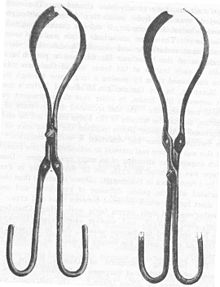
Dussee French forceps (circa 1725) with 2 unlike locks
In 1813, Peter Chamberlen's midwifery tools were discovered at Woodham Mortimer Hall well-nigh Maldon (UK) in the attic of the house. The instruments were found along with gloves, old coins and trinkets.[xv] The tools discovered too independent a pair of forceps that were assumed to accept been invented by the father of Peter Chamberlen because of the nature of the design.[xvi]
The Chamberlen family's forceps were based on the idea of separating the two branches of "saccharide clench" (every bit those used to remove "stones" from bladder), which were put in place i afterwards another in the nascence canal. This was not possible with conventional tweezers previously tested. However, they could just succeed in a maternal pelvis of normal dimensions and on fetal heads already well engaged (i.e. well lowered into maternal pelvis). Abnormalities of pelvis were much more mutual in the past than today, which complicated the use of Chamberlen forceps. The absence of pelvic curvature of the branches (vertical curvature to accommodate the anatomical curvature of maternal sacrum) prohibited blades from reaching the upper-function of the pelvis and exercising traction in the natural axis of pelvic excavation.
In 1747, French obstetrician Andre Levret, published Observations sur les causes et accidents de plusieurs accouchements laborieux (Observations on the Causes and Accidents of Several difficult Deliveries), in which he described his modification of the instrument to follow the curvature of the maternal pelvis, this "pelvic curve" allowing a grip on a fetal head yet high in the pelvic excavation, which could assist in more difficult cases.

Outset illustration of Levret'south pelvic curve – 1747
This improvement was published in 1751 in England by William Smellie in the book A Treatise on the theory and practice of midwifery. Afterward this fundamental improvement, the forceps would become a mutual obstetrical instrument for more than two centuries.

French forceps, Levret-Baudelocque type (1760–1860) with perforator and claw at the end of the handles
The last improvement of the instrument was added in 1877 by a French obstetrician, Stephan Tarnier in "descriptions of two new forceps." This musical instrument featured a traction system misaligned with the instrument itself, sometimes called the "third curvature of the forceps". This especially ingenious traction system, immune the forceps to exercise traction on the caput of the child following the centrality of the maternal pelvic excavation, which had never been possible before.

Tarnier forceps with tractor handle (1877) and USA Dewey model (1900)
Tarnier's idea was to "split" mechanically the grabbing of the fetal head (betwixt the forceps blades) on which the operator does non intervene after their correct positioning, from a mechanical accessory assault the forceps itself, the "tractor" on which the operator exercises traction needed to pull down the fetal head in the right centrality of the pelvic excavation. Tarnier forceps (and its multiple derivatives under other names) remained the nearly widely used organisation in the earth until the evolution of the cesarean department.
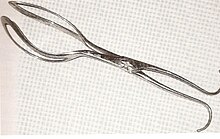
Hodge "Eclectic" forceps – USA (1833)
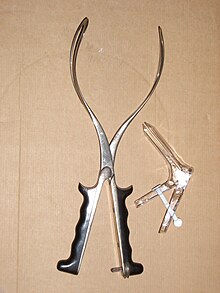
Elliott forceps with "pressure regulating" spiral at the finish of handles – Us (1860)
Forceps had a profound influence on obstetrics every bit it immune for the speedy delivery of the baby in cases of hard or obstructed labour. Over the course of the 19th Century, many practitioners attempted to redesign the forceps, so much then that the Royal College of Obstetrics and Gynecologists' collection has several hundred examples.[17] In the last decades, however, with the ability to perform a cesarean section relatively safely, and the introduction of the ventouse or vacuum extractor, the employ of forceps and training in the technique of its employ has sharply declined.
Historical office in the medicalisation of childbirth [edit]
The introduction of the obstetrical forceps provided huge advances in the medicalisation of childbirth. Before the eighteenth century, childbirth was thought of as a medical phase that could be overseen past a female person relative. Usually if a doctor had to get involved that meant something had gone wrong. Effectually this era, (eighteenth century) there were no female doctors. Since males were just exclusively called in nether extreme circumstances, the human activity of childbirth was thought to exist better known to a midwife or female relative rather than a male doctor. Unremarkably the male physician'southward job was to save the mother'due south life if, for example, the baby had become stuck on his or her way exiting the mother.
Before the obstetrical forceps, this had to be done by cutting the babe out piece by piece. In other cases, if the baby was deemed undeliverable, and then the doctor would apply an item called a crochet. This was used to crush the babe's skull allowing the baby to exist pulled out of the mother'due south womb. However in other cases, a caesarean department (c section) could exist performed, simply this would almost always result in the female parent'due south death. "In add-on, women who had forceps deliveries had shorter after childbirth complications than those who had caesarean sections performed."[xviii] These procedures came with diverse risks to the mother's health forth with the death of the baby.
Withal, with the introduction of the obstetrical forceps the male medico had a more than of import role. In many cases, they could actually salvage the infant'due south life if called early enough. Although the utilise of the forceps in childbirth came with its own ready of risks, the positives included a significant subtract in risk to the mother, a subtract in child morbidity, and a decrease risk to the baby. The forceps gave male doctors a fashion to deliver babies. Since the forceps in childbirth were made public around 1720, they gave male doctors a way to assist and fifty-fifty oversee childbirths.
Effectually this time, in large cities some notable existence London and Paris, some men would become devoted to obstetrical practices. It became fashionable among wealthy women of the era to have their childbirth overseen by male midwives. A notable male midwife was William Hunter. He popularised obstetrics. "In 1762, he was appointed equally obstetrician to Queen Charlotte."[xix] In improver, with the employ of forceps, male doctors invented lying in hospitals to provide safe, somewhat advanced obstetrical intendance because of the utilize of the obstetrical forceps.
Historical complications [edit]
Child nascence was not considered a medical practice before the eighteenth century. It was mostly overseen by a midwife, mother, stepmother, neighbour, or whatever female relative. "Around the 19th and 20th Century, childbirth was considered unsafe for women."[20] With the introduction of obstetrical forceps, this immune non-medical professionals, such as the aforementioned individuals, to go on to oversee childbirths. In improver, this gave some of the public more condolement in trusting childbirth oversight to common people. However, the introduction of obstetrical forceps as well had a negative result, because there was no medical oversight of childbirth by whatever kind of medical professional, this exposed the practice to unnecessary risks and complications for the fetus and mother. These risks could range from minimal effects to lifetime consequences for both individuals. The baby could develop cuts and bruises in diverse trunk parts due to the forcible squeezing of his or her body through the mother'south vagina. In addition, in that location could be bruising on the baby's face if the forceps' handler were to squeeze also tight. In some extreme cases, this could cause temporary or permanent facial nerve injury. Furthermore, if the forceps' handler were to twist his or her wrist while the grip was on the infant's head, this would twist the baby'southward cervix and cause impairment to a cranial nerve, resulting in strabismus. In rare cases, a clavicle fracture to the baby could occur. The improver of obstetrical forceps came with complication to the mother during and afterward childbirth. The apply of the forceps gave rise to an increased chance in cuts and lacerations along the vaginal wall. This, in turn, would cause an increase in postal service-operative recovery fourth dimension and increase the pain experienced by the mother. In addition, the use of forceps could crusade more difficulty evacuating during the recovery time as compared to a mother who did not use the forceps. While some of these risks and complications were very common, in full general, many people disregarded them and connected to use them.
See as well [edit]
- Instruments used in full general surgery
References [edit]
- ^ Murphy, Deirdre J; Liebling, Rachel Eastward; Verity, Lisa; Swingler, Rebecca; Patel, Roshni (2001). "Early maternal and neonatal morbidity associated with operative delivery in 2d stage of labour: A cohort study". The Lancet. 358 (9289): 1203–7. doi:10.1016/S0140-6736(01)06341-3. PMID 11675055. S2CID 205937677.
- ^ Loughnan, Michael Due south.; Adrian Due south. Bruce (2002). Anterior Center Affliction and Therapeutics A-Z. Oxford: Butterworth-Heinemann. p. 91. ISBN0-7506-5261-6.
- ^ O'Mahony, Fidelma; Settatree, Ralph; Platt, Craig; Johanson, Richard (May 2005). "Review of singleton fetal and neonatal deaths associated with cranial trauma and cephalic delivery during a national intrapartum-related confidential research". BJOG: An International Journal of Obstetrics & Gynaecology. 112 (5): 619–626. doi:10.1111/j.1471-0528.2004.00508.x. ISSN 1470-0328. PMID 15842287. S2CID 11180868.
- ^ a b c d due east f g Healthline > Types of Forceps Used in Delivery February 2006. Reviewer: Douglas Levine, Gynecology Service/Department of Surgery, Memorial Sloan Kettering Cancer Center, New York, NY.
- ^ Asyncletism in labor, spinningbabies.com
- ^ Family unit Practice Notebook > Forceps Assisted Delivery Archived four Oct 2009 at the Wayback Machine written by Scott Moses, MD. This page was last revised before 5/x/08
- ^ a b Chamberlain, G; Steer, P (1999). "ABC of labour care: Operative delivery". BMJ. 318 (7193): 1260–4. doi:x.1136/bmj.318.7193.1260. PMC1115650. PMID 10231260.
- ^ Derived from the lbf value with 1 lbf ≈ 4.45 N
- ^ Dennen, Edward H. (1989). Dennen's Forceps Deliveries (tertiary ed.). F.A. Davis. ISBN0-8036-2511-one.
- ^ biological science-online.org > Dictionary » O » Outlet forceps delivery Page concluding modified 21:16, three October 2005.
- ^ a b c d Types of Forceps Deliveries: Outlet, Low, Mid, and High Archived 20 January 2010 at the Wayback Machine Reviewer: Douglas Levine. Healthline Pregnancy Guide, February 2006
- ^ Moore, Wendy (2007). "Keeping mum". BMJ. 334 (7595): 698.2–698. doi:x.1136/bmj.39157.514815.47. PMC1839178.
- ^ Watts, Geof. 2001. Special Delivery. New Scientist. 21 April 4848
- ^ 1886. The Last Lyons Forceps. The Medical News. two January 14
- ^ Murphy, Edwardw (1845). "Lectures on the Mechanism and Management of Natural and Hard Labours". The Lancet. 46 (1140): 57–61. doi:10.1016/S0140-6736(02)86183-9.
- ^ Aveling, J.H. 1882. The Chamberlens and the Midwifery Forceps 224
- ^ Robson, Steve (2009). "Forceps Delivery: Science Wears its Art on its Sleeve". O&G. 11 (4): 19–20.
- ^ Patel, Roshni R; Murphy, Deirdre J (2004). "Forceps delivery in modern obstetric do". BMJ. 328 (7451): 1302–5. doi:10.1136/bmj.328.7451.1302. PMC420176. PMID 15166069.
- ^ Sheikh, Sukhera; Ganesaratnam, Inithan; Jan, Haider (2013). "The birth of forceps". JRSM Short Reports. iv (seven): 1–four. doi:ten.1177/2042533313478412. PMC3704058. PMID 23885296.
- ^ Drife, J (2002). "The outset of life: A history of obstetrics". Postgraduate Medical Periodical. 78 (919): 311–five. doi:10.1136/pmj.78.919.311. PMC1742346. PMID 12151591.
External links [edit]
- GLOWM video demonstrating forceps delivery technique
Source: https://en.wikipedia.org/wiki/Obstetrical_forceps
0 Response to "Can Forceps Leave Dents in the Baby's Skull"
Post a Comment